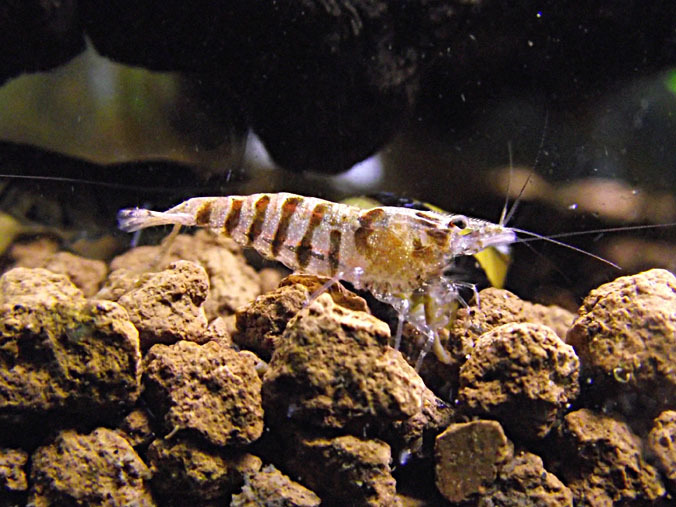Breeding Freshwater Back Stripe Shrimp:
With the ever-growing popularity of planted aquaria, freshwater invertebrates are enjoying an increase in popularity as well. It’s no surprise since many of these inverts are perfect residents for these setups. One of the more popular freshwater invertebrates is the Back stripe shrimp. These shrimp belong to the genera Caridina. There are over 120 different species of Caridina shrimp. It is almost impossible to identify these shrimp to the species level. The freshwater shrimp hobby is going thru much the same identity crisis as South American catfish, many of which are being identified by a number. Caridina shrimp are usually referred to by their common name or simply as a Caridina species or something else equally inaccurate. What makes all of the shrimp in this Genus so desirable is that they will spend 24 hours a day (that’s right they don’t sleep) cleaning your tank of leftover food scraps and algae without bothering your plants in any way.
Identification issues aside, the Back stripe shrimp is fairly easy to identify. They are very small. Adults will max out at about 11/4”, females being slightly larger than males. Since the females carry their eggs under their abdomen, they are deeper bodied. When young the shrimp are translucent covered in brownish dots and squiggles. As they mature the translucent color darkens to a more solid brownish color with a lighter stripe down their backs. They look a lot like Red Cherry shrimp but in earth tones. The females, when carrying eggs, will become more intensely colored. All of the Caridina shrimp have tiny claws and are completely harmless.
These shrimp are fairly easy to keep and breed. Their husbandry reminds me of keeping fancy guppies. They can be delicate at first, but when fully acclimated and settled in they are hardy. They will do fine at room temperature. They can tolerate temperatures up to 28oC but in the long run, they will do best a little cooler (23-25oC). The pH should be slightly acidic, 6.6-6.8 is fine. GH is important to these guys. Water that is too soft will not provide them with enough minerals to properly form their shells. I keep mine GH at about 6-8o but do not exceed 10o. Many fishkeepers raise their GH with Epsom salt. Epsom salt is composed of Magnesium Sulfate. While this may be fine for fish, I cannot endorse it for the raising of shrimp. The shells of shrimp are composed primarily of calcium, so magnesium is not really addressing their needs. I use Seachems Equilibrium which contains a good dose of calcium along with some other minerals.
You can keep them in a small nano tank or a large display tank, but it should be a mature planted aquarium. If you are using a power or canister filter and do not place some sort of fine mesh or pre-filter over the intake strainer you will find these guys living in your filter. In the wild these shrimp congregate in dense populations so don’t just get a few, get as many as you can. The Caridina shrimp are true omnivores. They will eat virtually anything organic. Food pellets of any type, flakes, frozen foods like bloodworms and brine shrimp, algae, decaying plant leaves, dead fish, and even the bio-film covering everything in your fish tank are all on the menu. Most of the time I let them eat whatever algae and food scraps the fish miss, but Hikari produces a specialty food called Crab Cuisine. It is developed for crustaceans and is high in minerals. I feed them this product once or twice a week.
They will breed freely on their own, requiring nothing more than your normal maintenance routine. The eggs are fairly large and will range in number from about 20-40. The newly hatched shrimp are extremely tiny, but they are fully formed. They will hatch out in 28-33 days. Since the adults will not bother the hatchlings they do not need to be removed. The hatchlings are quite self-sufficient. They will forage for food on their own, so no special feeding regime is required. Mine are breeding colony style in my 25-gallon Guppy Tank. It’s a heavily planted aquarium and most of the time you do not see all that many of them, but drop in a food pellet and they swarm out of hiding in massive numbers.
I know this all sounds very easy, but they do have two special requirements that you will need to respect. As any reef keeper can tell you, invertebrates are extremely sensitive to Copper. Even very small amounts can wipe them out. Freshwater invertebrates have the same sensitivity. Obviously, any medication that contains copper cannot be used, but Copper can get into your system by unanticipated means. If you have copper water pipes in your home you need to let the water run for a while prior to use because water standing in your pipes can absorb some Copper. You should also draw cold water since less Copper will dissolve in cold water than hot. Another way that Copper sneaks into your system is by food. Some commercially prepared fish foods contain Copper salts and are not suitable so read that ingredient label. The other special requirement is Iodine. The shrimp need this to molt properly. Make sure you use Iodine and not Iodide. I use Kent Marine Iodine and dose it at a rate of 0.2ml per every five gallons with each weekly water change. Buy a small bottle, it is going to last a long time. That’s all that’s required so have fun.

